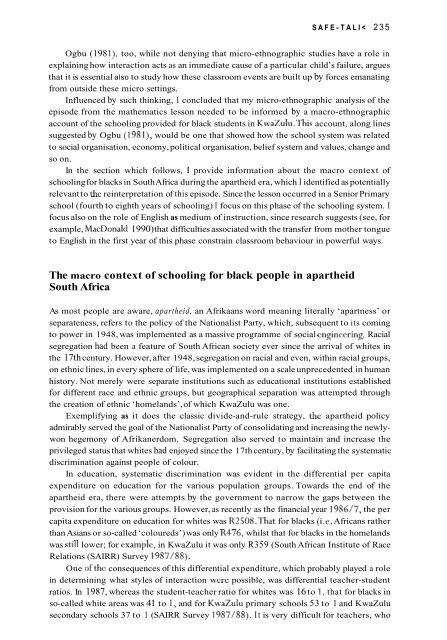English Language Teaching in its Social Context
English Language Teaching in its Social Context
English Language Teaching in its Social Context
Create successful ePaper yourself
Turn your PDF publications into a flip-book with our unique Google optimized e-Paper software.
SAFE-TALI< 235Ogbu (198 l), too, while not deny<strong>in</strong>g that micro-ethnographic studies have a role <strong>in</strong>expla<strong>in</strong><strong>in</strong>g how <strong>in</strong>teraction acts as an immediate cause of a particular child’s failure, arguesthat it is essential also to study how these classroom events are built up by forces emanat<strong>in</strong>gfrom outside these micro sett<strong>in</strong>gs.Influenced by such th<strong>in</strong>k<strong>in</strong>g, I concluded that my micro-ethnographic analysis of theepisode from the mathematics lesson needed to be <strong>in</strong>formed by a macro-ethnographicaccount of the school<strong>in</strong>g provided for black students <strong>in</strong> KwaZulu.This account, along l<strong>in</strong>essuggested by Ogbu (1981), would be one that showed how the school system was relatedto social organisation, economy, political organisation, belief system and values, change andso on.In the section which follows, I provide <strong>in</strong>formation about the macro context ofschool<strong>in</strong>g for blacks <strong>in</strong> South Africa dur<strong>in</strong>g the apartheid era, which I identified as potentiallyrelevant to the re<strong>in</strong>terpretation of this episode. S<strong>in</strong>ce the lesson occurred <strong>in</strong> a Senior Primaryschool (fourth to eighth years of school<strong>in</strong>g) I focus on this phase of the school<strong>in</strong>g system. Ifocus also on the role of <strong>English</strong> as medium of <strong>in</strong>struction, s<strong>in</strong>ce research suggests (see, forexample, MacDonald 1990) that difficulties associated with the transfer from mother tongueto <strong>English</strong> <strong>in</strong> the first year of this phase constra<strong>in</strong> classroom behaviour <strong>in</strong> powerful ways.The macro context of school<strong>in</strong>g for black people <strong>in</strong> apartheidSouth AfricaAs most people are aware, apartheid, an Afrikaans word mean<strong>in</strong>g literally ‘apartness’ orseparateness, refers to the policy of the Nationalist Party, which, subsequent to <strong>its</strong> com<strong>in</strong>gto power <strong>in</strong> 1948, was implemented as a massive programme of social eng<strong>in</strong>eer<strong>in</strong>g. Racialsegregation had been a feature of South African society ever s<strong>in</strong>ce the arrival of whites <strong>in</strong>the 17th century. However, after 1948, segregation on racial and even, with<strong>in</strong> racial groups,on ethnic l<strong>in</strong>es, <strong>in</strong> every sphere of life, was implemented on a scale unprecedented <strong>in</strong> humanhistory. Not merely were separate <strong>in</strong>stitutions such as educational <strong>in</strong>stitutions establishedfor different race and ethnic groups, but geographical separation was attempted throughthe creation of ethnic ‘homelands’, of which KwaZulu was one.Exemplify<strong>in</strong>g as it does the classic divide-and-rule strategy, the apartheid policyadmirably served the goal of the Nationalist Party of consolidat<strong>in</strong>g and <strong>in</strong>creas<strong>in</strong>g the newlywonhegemony of Afrikanerdom. Segregation also served to ma<strong>in</strong>ta<strong>in</strong> and <strong>in</strong>crease theprivileged status that whites had enjoyed s<strong>in</strong>ce the 17th century, by facilitat<strong>in</strong>g the systematicdiscrim<strong>in</strong>ation aga<strong>in</strong>st people of colour.In education, systematic discrim<strong>in</strong>ation was evident <strong>in</strong> the differential per capitaexpenditure on education for the various population groups. Towards the end of theapartheid era, there were attempts by the government to narrow the gaps between theprovision for the various groups. However, as recently as the f<strong>in</strong>ancial year 1986/7, the percapita expenditure on education for whites was R2508.That for blacks (i.e. Africans ratherthan Asians or so-called ‘coloureds’) was only R476, whilst that for blacks <strong>in</strong> the homelandswas still lower; for example, <strong>in</strong> KwaZulu it was only R359 (South African Institute of RaceRelations (SAIRR) Survey 1987/88).One ofthc consequences of this differential expenditure, which probably played a role<strong>in</strong> determ<strong>in</strong><strong>in</strong>g what styles of <strong>in</strong>teraction were possible, was differential teacher-studentratios. In 1987, whereas the student-teacher ratio for whites was 16 to 1, that for blacks <strong>in</strong>so-called white areas was 41 to 1, and for KwaZulu primary schools 53 to 1 and KwaZulusecondary schools 37 to 1 (SAIRR Survey 1987/88). It is very difficult for teachers, who












